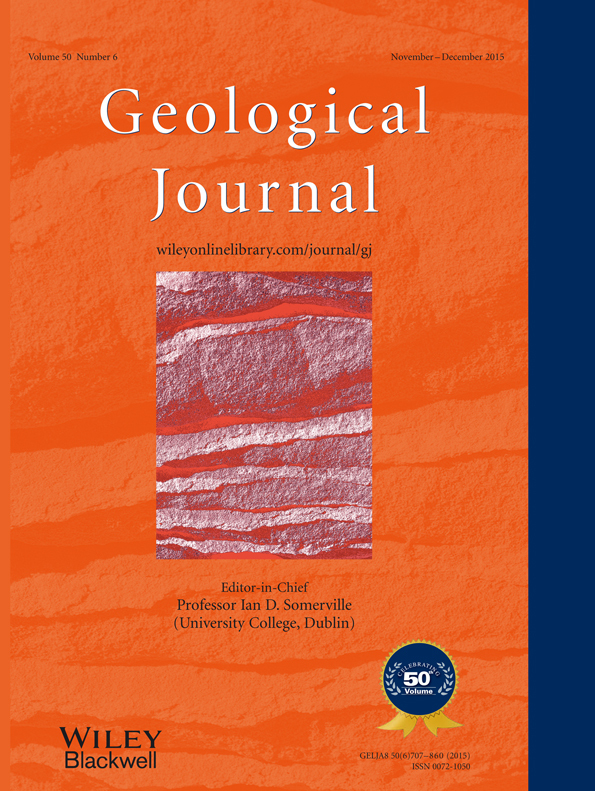Reliability of digit length impression as a character of tetrapod ichnotaxobase: considerations from the Carboniferous–Permian ichnogenus Ichniotherium
Abstract
Although the relative length of digit impressions is often adopted as a binding character in ichnotaxa discrimination and trackmaker identification, it cannot be considered unequivocally operative. The reliability of this character has been evaluated by means of principal component analysis on several well-preserved footprints (both manus and pes) referred to as Ichniotherium sphaerodactylum from the Early Permian Tambach Formation (Thuringia, Germany). The analysis reveals a substantial variability of digit impression length (especially in the manus), relativizing the validity of digit IV length as a diagnostic character as practised in different ichnological studies. Regarding the use of such a character, results clearly suggest the need to preliminarily conduct explorative analysis on the whole available ichnological material in order to detect which digit is the most consistent from an ichnotaxonomical standpoint, thus avoiding an arbitrary selection. Such a preliminary analysis should provide a better control on ichnotaxonomical splitting/lumping, particularly in the case of allied footprints, and can also be considered a valuable tool, if associated to functionality analysis, in improving and refining trackmaker identification. Copyright © 2014 John Wiley & Sons, Ltd.
1 Introduction
In the literature, different measurement methods of digit length can be found. According to Leonardi (1987), ‘…different criteria must be considered, according to the shape of the footprint and its preservation’ (Leonardi, 1987, p. 47). Undoubtedly, the comprehension of preservational features of analysed material and the selection of optimal reference points as a basis for measurements are crucial to obtain reliable and communicable data. A way to overcome this problem is to choose reference points that are strictly anatomically but not substrate-controlled. Substrate-related or extramorphological factors often cause inaccurate measurements and variation within the same trackway. For example, the free length method refers to the ‘…measure (taken along the chord) of the segment that joins the distal extremity of the digit to the mid-point of the distance between two adjacent hypexes’ (Leonardi, 1987, p. 47); for lateral digits having only one adjacent hypex (e.g. digits I and V in pentadactyl footprints), the mid-point of the distance between two adjacent hypexes have necessarily to be substituted by ‘…the mid-point of the line perpendicular to the axis of the digit that passes through the adjacent hypex’ (Leonardi, 1987, p. 47, plate V, G). An example of a measurement method with no anatomical significance is that of communal length (sensu Peabody, 1948), corresponding to the difference between the digit length (i.e. the measure of the line joining the distal digit tip with the hind point of the last visible phalangeal pad; Leonardi, 1987) and that of the free length of digit (measure of the segment joining the distal digit tip to the mid-point of the distance between two adjacent hypexes). Such a method repeats a dimensional measure unable to connect the ichnological datum to an osteological information, potentially crucial in characterizing the acropodial structure of the trackmaker.
The most useful method to obtain anatomical information about the trackmaker is the measure of the digit phalangeal portion length, concerning ‘…the measure of the segment that joins the distal extremity of the digit with the corresponding mid-point of the metapodial-phalangeal pad’ (Leonardi, 1987, p. 47), which is more closely related to the real anatomical length of the digit.
The relative digit length is a character commonly used in ichnological descriptions and diagnoses, both for ichnotaxa differentiation and in the search for a putative trackmaker (e.g. Currie, 1981; Lockley et al., 1992; Doyle et al., 2000; Voigt et al., 2005, 2007; Voigt and Ganzelewski, 2010; Sacchi et al., 2014). Despite the weight traditionally ascribed to such a character, the digit length can change consistently even within the same trackway, due to factors both directly related to the mode of locomotion and interaction between substrate and autopods and of a purely taphonomic nature (substrate conditions and relative footprint preservational type). In this paper, this issue has been experimentally addressed taking into account the well-preserved footprints referred to Ichniotherium sphaerodactylum (sensu Voigt et al., 2007) stored at the Museum der Natur in Gotha (Thuringia, Germany).
The possibility to consider individual tracks assigned to a putative unitary trackmaker to be found within the Diadectidae (see Haubold, 2000; Voigt et al., 2005, 2007; Voigt and Ganzelewski, 2010, among others) has allowed us to analyse in detail the impression range of each digit within the same trackway and to understand how the average length varies in the considered material. The quantization and the understanding of the taxonomic or simply behavioural–structural factors upon which the variability is based result in an important key element for a correct interpretation of the relative digits length and for its reliability in ichnotaxonomic diagnosis.
2 Materials and Methods
To perform the study, several specimens ascribed to the well-known Carboniferous–Permian ichnogenus Ichniotherium have been comparatively analysed from the rich collection of the Museum der Natur in Gotha (MNG-1351, MNG-1515, MNG-1840, MNG-1846, MNG-2356/14, MNG-2356/15, and MNG-10072). The multivariate and bivariate analyses have been conducted on five trackways of quadrupeds confidently attributable to a unitary ichnotaxon, and most likely to a unitary putative trackmaker (MNG-1351, MNG-1515, MNG-1840, MNG-1846, and MNG-10072). For each slab, only the best-preserved footprints have been analysed, excluding the impressions affected by cracks potentially distorting the measures. For the analysis, 23 pes and 22 manus impressions have been considered. For measurements, the phalangeal portion length of digits has been used, taking as homologous points the digit tips, distally, and the centre of the metapodial-phalangeal pad, proximally (Fig. 1). In cases where the pad is not imprinted, as in the lateral digits of the pes, its position has been estimated by continuing the arc of the metapodial-phalangeal joint, starting from the preserved pads. The complete list of measures is shown in Appendix 1.
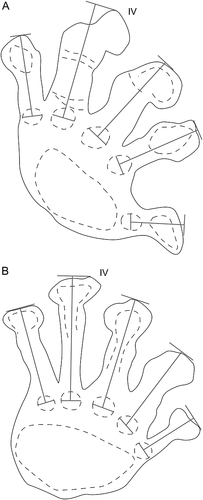
The collected data have been subjected to a principal component analysis (PCA) with Paleontological Statistics 2.06 (PAST) software (Hammer, 2011). According to Bookstein et al. (1985), the raw data have been log-transformed to fit linear models and for the correspondence of the log-transform to an isometric null hypothesis (examples of this procedure are found in Smith, 1998; Chinnery, 2004; Cheng et al., 2009).
In addition to the multivariate analysis, digit relative lengths for each considered footprints have been plotted on XY graphs and grouped by the tracks to which they belong. Furthermore, for each digit, the standard deviation has been considered for pedes and manus constituting a single trackway; the results for each slab were then averaged to obtain a general trend of the variability for digit length. The analyses have been conducted separately for manus and pedes, and the two general results are compared and discussed in a final graph. The standard deviation has been calculated using PAST (2.06, Hammer, 2011) software.
Multivariate analysis of digit impressions variability has been preceded by a preliminary classical ichnological study reported in the following section, with the characterization of trackway principal parameters. For most of the measurements and terminology, we follow the methods of Leonardi (1987). Measured parameters are external trackway width, width between tracks, oblique pace length, stride length, pace angulation, rotation of manus and pes imprints relative to the midline, digits divarication, and gleno-acetabular distance. The ratio stride length : pes length (relative stride length) and the ratio stride length : gleno-acetabular distance have been also calculated. In very few cases, the cross-axis angle could be unequivocally measured, once the metapodial-phalangeal axis is identified. To perform the trackway measurements on Ichniotherium specimens, the metapodial-phalangeal pad III has been considered as a homologous point, in both manus and pedes.
3 Ichnotaxonomical Status of Ichniotherium Sphaerodactylum
Before proceeding with the analysis of the studied material, it seems appropriate to briefly discuss the present state of Gotha specimens ichnotaxonomy. Ichniotherium is a typical component of the Rotliegend (Lower Permian) ichnofauna. In a global view, the record of Ichniotherium from Thuringia is by far the best, both qualitatively and quantitatively, also considering that, apart from Ichniotherium willsi (Haubold and Sarjeant, 1973), Ichniotherium praesidentis (Voigt and Ganzelewski, 2010), and Ichniotherium accordii (Ceoloni et al., 1988), most of the other material is preserved as single imprints or partial trackways (Gand, 1987; Haubold, 1973; Haubold and Stapf, 1998).
Ichnological studies at the Bromacker site began at the end of the 19th century, when Pohlig (1885) established the ichnotaxon Ichniotherium cottae. Shortly afterwards, Pabst (1895, 1908) described a second ichnospecies I. sphaerodactylum and the subichnospecies I. sphaerodactylum minor from the same locality. Haubold (1971, 1973) considered I. sphaerodactylum as a junior synonym of I. cottae.
A very accurate analysis of the Ichniotherium cottae variability has been subsequently performed (Voigt and Haubold, 2000). These authors recognized two distinct morphotypes (morphotype A and morphotype B), showing some differences in footprint morphology and trackway pattern (i.e. variation in depth and completeness of imprints, relative position and dimension of digit V of the pes, and arrangement of manus and pedes within the trackway), ascribed to different gait and different consistency of the substrate.
However, in 2005, a prolific Ichniotherium cottae track site was discovered in red beds of the Maroon Formation near Maroon Bells, central Colorado (Voigt et al., 2005). This new find enables us to abandon previous explanations for the differences in the two morphotypes of Ichniotherium (Voigt et al., 2005). In fact, as also subsequently stated by the authors regarding the Colorado specimens, ‘…trackways segments and hundreds of isolated imprints of Ichniotherium were recorded that are identical to the morphotype B tracks of the Bromacker locality’ (Voigt et al., 2007, p. 556). According to the authors, this increase in the ichnological database indicates that two different ichnospecies, I. sphaerodactylum and I. cottae, respectively referred to as morphotypes A and B (Voigt and Haubold, 2000), occur at the Bromacker locality. The two ichnotaxa differ in the lengths of digit V, being shorter in the former ichnospecies, and in the ratio of the pes stride length to the apparent body length (i.e. gleno-acetabular distance), being larger in I. cottae. A minor difference concerns the two co-joined semicircular outlines of the sole pad of the pes in Ichniotherium cottae, a feature probably dependent on the depth of impression (Voigt et al., 2007).
Therefore, Voigt et al. (2007) confirm the statement made in 2005, revalidating the two ichnospecies and identifying the two diadectids Diadectes absitus and Orobates pabsti as the trackmakers of Ichniotherium cottae and Ichniotherium sphaerodactylum, respectively.
4 Ichnological Analysis
4.1 Tracks and trackways parameters
The chance of being able to observe different footprints of the same trackway allowed understanding of track variability in subsequent sets, in terms of both overall shape and depth of impression.
All the observed tracks and trackways, preserved as natural casts (convex hyporelief), were left by quadrupedal, plantigrade, and pentadactyl trackmakers, ranging from 232 to 318 mm in gleno-acetabular distance. Different types of footprint preservation can co-occur on the same slab (e.g. MNG-1840 and MNG-1515, Fig. 2) and within the same trackway. An example is the trackway on slab MNG-10072, where the first and second sets are represented only by the digit distal tips; the third set preserves only the medial and distal portions of digits in the pes and an incomplete impression of the palm in the manus. From the fifth set to the end of the trackway, footprints are completely preserved (Fig. 3).
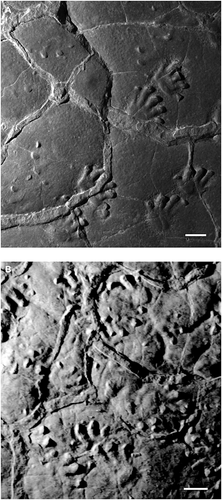
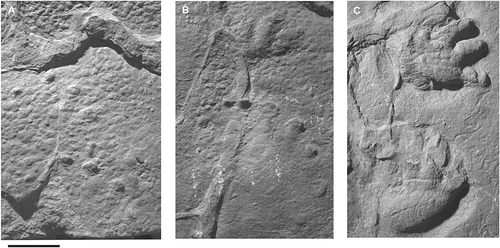
Patterns of the trackways may include an alternating arrangement of coupled manus–pes footprints (e.g. MNG-10072), in which a manus on one side of the trackway is contralateral with respect to the pes of the other side, and vice versa for the pes, or an alternating arrangement of the single footprint, where only the distal portion of the manus is contralateral to the proximal portion of the opposite pes (e.g. MNG-1351, MNG-1840, and MNG-1846; Figs. 2A and 4). The pattern is slightly variable, depending on the stride length and on the apparent body length (i.e. gleno-acetabular distance), from trackway to trackway and within the same trackway (e.g. MNG-10072). All the trackways show a primary overlap. It can be marginal and rarely partial, with the pes posed on the proximal portion of the corresponding manus (e.g. MNG-1515). Hind and foreprint are strongly homopodic. The manus is always wider than long, with an average length of about 80 mm and an average width of about 100 mm, while the pes is as long as it is wide; on average, the pes length is about 110 mm. The oblique pace ranges from 203 to 309 mm for pedes, while it varies from 193 to 282 mm in manus. The stride length in pedes ranges from 224 to 436 mm; in manus, this value is between 296 and 448 mm. The pace angulation ranges between 62° and 110° in pedes and from 91° to 133° in manus. The cross-axis angle results about 95° in the pes and 100° in the manus. The ratio stride : pes length varies from 3:1 to 3.6:1, and the ratio stride : gleno-acetabular distance is between 1.3:1 and 1.4:1.
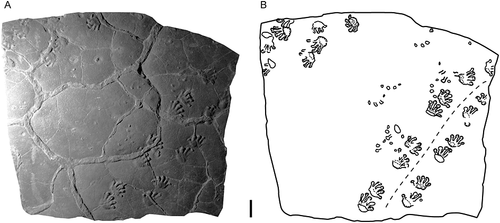
Pedes are almost subparallel with respect to the trackway midline, or at least negatively rotated (i.e. turned towards the midline) with an angle between 5° and 13°. Manus are always negatively rotated with an angle highly variable from about 15° to 80°.
Some trackways have a slightly curvilinear midline (e.g. MNG-1840; Fig. 4); on the side of midline concavity, that is also the side of bending, the step is shorter and stride values are lower than those measured on the preceding set. In these trackway sections, also pace angulation is lower, and manus reach the maximum angle of divarication from the midline.
A rather recurrent feature is the greater variability of some parameters measured on manus, such as pace angulation and rotation from the midline.
In the pes, the sole pad has a sub-oval to flattened ellipsoidal shape and subtends an area extending behind digits I to V, when completely impressed. In front of the distally sloping sole of the pes, a transverse groove is situated. This groove, corresponding to a non-imprinted area, is gradually shallower towards the lateral portion of the footprint and extends from digits I to IV, tapering and becoming shallower both medially and laterally. In the manus, the palm pad has a similar shape to that of the pes sole pad. Sometimes, it consists of two roughly subcircular distinct impressions, the medial one extending behind digits I–III, the other behind the lateral digits.
Metapodial-phalangeal pads are roughly subcircular in shape; sometimes, in both manus and pes, those centrals can merge, resulting in an arc-shaped morphology more deeply imprinted in its central part (e.g. MNG-1846, set 2).
Digits are straight proximally and subparallel to each other. They have drum-stick-like broad tips that are sometimes bent inward. In both the manus and pes, digit I can be slightly adducted; when preserved, digit V in the pes is always straight and subparallel to digit IV, while in the manus it can be abducted. The divarication angle between digits I and IV is about 60° to 70° in the pes and about 60° to 100° in the manus. Sometimes, digits are knobby in appearance and characterized by shallow furrows. These structures are posed roughly transversely with respect to the digit long axis and are more frequent in the proximal and central portions of the central digits (e.g. MNG-1351, MNG-1515, MNG-1846, and MNG-1840) or at least present behind the distal tip (Fig. 5A, B). Other recurrent features are the sliding traces posed laterally to the central digit tips, roughly directed towards the trackway midline and often related to a peculiar mode of tip impression (e.g. MNG-1840, set 3, digit II; Fig. 5C). The latter shows a major prominence of the distal portion indicating a greater push of the distal phalanges directed forwards and downwards, probably during the kick-off phase and subsynchronous with the digit rotation and sliding, which probably are liable of the lateral traces.
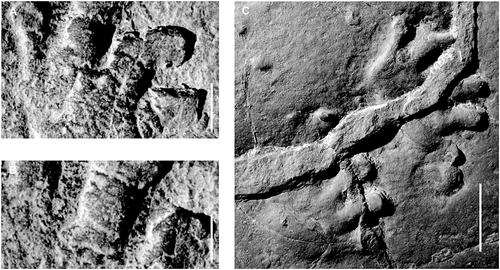
4.2 Multivariate and bivariate analyses
A first principal component analysis (PCA) has been conducted considering simultaneously the measures for manus and pedes in the dataset (Appendix 1). The analysis, based on a correlation matrix, showed that about 67.78% of the variance was resolved into the first principal component and about 20.69% into the second one. Thus, the first two principal components account for about 88.47% of the variance for the analysed dataset. In Figure 6, the bivariate graph of principal component 1 against the second is shown. Each reported convex hull encloses respectively the manus and pedes belonging to the same trackway, therefore footprints left by a unique animal with the same ontogenetic and taphonomic conditions. As can be seen in the bivariate graph, the convex hulls identified by the manus and pedes are quite separated, although major differences between the two groups may be noted. In fact, it is evident how the convex hulls of the pedes are much more concentrated compared with those identified by the manus, with lower variation along both components 1 and 2. In particular, pedes convex hulls largely overlap, showing a field of variability that is much more restricted compared with that of the manus. Loadings (Appendix 2) showed that the first principal component results from a linear combination of all the five considered variables (length of the five digits positively correlated) and therefore represents most likely the dimensional factor (absolute size). Thus, convex hulls identified by manus and pedes, respectively, are substantially separated along the first principal component in relation to the absolute size, which is higher in the hindfoot compared with the forefoot impression. Differently, the second principal component results from an inverse correlation between the length of the first digit (highly positive load equal to 0.78, Appendix 2) and the length of the fifth (consistently negative load equal to −0.56). With respect to that component, while the convex hulls of the pedes are decidedly compact (low variability along the component), those identified by the manus are much broader (higher occupied morphospace), therefore indicating that the variability of the digit I–digit V correlation results more strongly in the impressions of front autopods with respect to the hind ones.
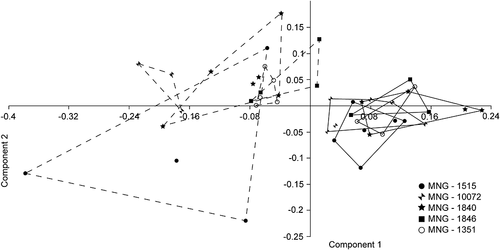
To go into more detail, two separate PCA applications have been conducted respectively on pedes and manus data. The bivariate graphs of the first principal component against the second reported in Figures 7 and 8 show a general structure very similar to that obtained in the general graph of Figure 6 (PCA inclusive of data from both manus and pedes). In fact, even in this case, pedes convex hulls are decidedly more compact and overlapping in respect to those with larger area and more dispersed of the manus. In the PCA conducted only on pedes (Fig. 7), the first principal component expresses approximately 51.93% of the variance and the second approximately 21.29% (in total the first two principal components account for about 73.22% of the variance); in the PCA conducted only on the manus (Fig. 8), the first component accounts for approximately 59.65% of the variance and the second approximately for 22.78% (82.43% of the total variance). As can be seen in Appendix 2, major differences are found in the loading for components 1 and 2, respectively, in manus and pedes. In both cases, the loads of the first principal component indicate a positive correlation of all the considered variables; however, while loads are mostly uniform in the pedes, in manus, the much greater load is found in digit I length and secondarily in the second one (by convention, loads greater than 0.3 and lower than −0.3 are significant). Therefore, while in the case of pedes, the dispersion along the first principal component may indicate largely the dimensional parameter (absolute size of the pedes impressions in the different considered trackways), for manus, the variance along the first principal component is determined basically by a direct correlation between the lengths of digits I and II, with greater load for the first digit (load equal to 0.86). As regards the second component, in the case of pedes, it results in an inverse linear combination between the second digit length (load equal to −0.44) and the fifth digit length (load equal to 0.83). In the manus, the component is a linear inverse combination between the length of digit I (load equal to −0.33) and the length of the remaining digits, with higher load found in lengths of digits IV and V (loads respectively equal to 0.51 and 0.7). In absolute, greater extent and therefore higher variability is observed in the case of the manus of slab MNG-1515 along the first principal component, indicating that the relative length of the first digit in subsequent footprints is mainly responsible for the variability in the analysed sample.
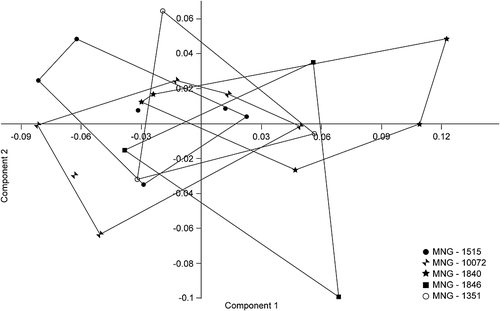
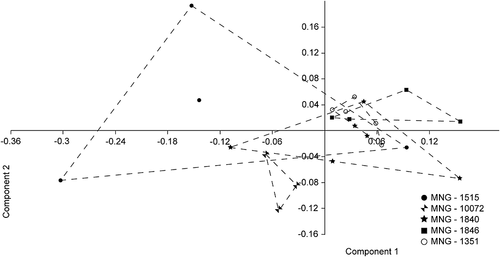
To better visualize the variability within each trackway, the digit lengths in the individual footprints of a slab have been plotted in the graphs shown in Figure 9. From an overall analysis of the graphs, the information obtained from the PCA result is confirmed, showing a trend towards the digit length being more stable in the pedes than in the manus. In particular, the impressions most variable in length are found in the manus of slab MNG-1515, while the smallest variants are found in the pedes from the same trackway. In addition, the graphs help to immediately visualize the variability in the length measured for each digit, with extremely little variable digits (e.g. digit III in pedes of MNG-1515) and highly variable impressions within the same trackway (e.g. digit V in the manus of MNG-1515).
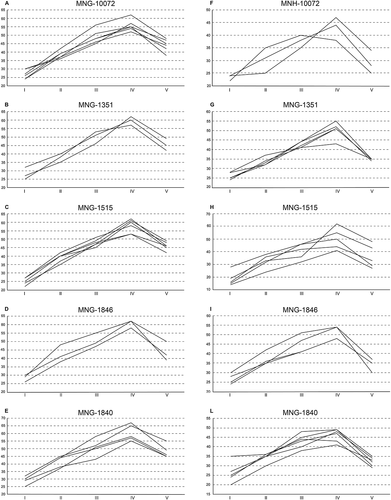
To get a more refined and quantitative estimate of the variability, the standard deviation for each digit has been considered (for both manus and pedes separately), calculated over all footprints considered from a trackway. Appendix 3 shows the standard deviations for each digit within the same trackway. Furthermore, for each digit (for both manus and pedes), the mean value of the standard deviations from the various trackways has been calculated (Fig. 10). The trend shown in this figure thus represents the average of the standard deviations obtained from the individual slabs and then provides an overall estimate of the variability for each particular digit. The graph is once again in agreement with the results obtained in the PCA and in the graphs shown in Figures 6-9. The variability of digit length in the manus (expressed by the standard deviation) is greater than the overall condition of the pedes, with the exception of the third digit, which shows an identical variance, and the fifth digit, that is more variant in the pedes. Peculiarities are the high variability of digits I and IV in the manus and the low variability of the first digit in the pes. The general considerations drawn from this analysis are reported and discussed in the following section.
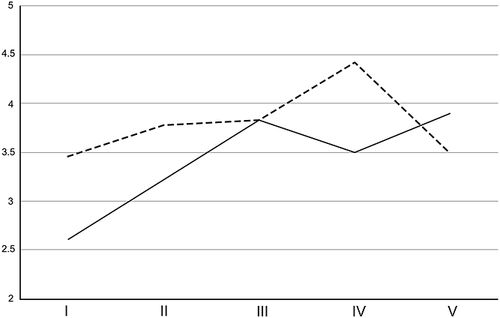
5 Discussion and Conclusions
The analysis conducted in this paper highlights, in both qualitative and quantitative manners, the variability of the digit impression length in a solid and unitary ichnotaxon. The case study is optimal since the footprints can be referred with a good chance to a unitary kind of putative trackmaker, as recently suggested by a functionality analysis performed on the same material, and therefore the peculiarities observed on different slabs can be traced to differences in posture and gait rather than a taxonomic diversity. This is definitely proven when data are based on imprints of the same trackway.
The results of the PCA (Figs. 6-8) and of bivariate graphs (Fig. 9) show quite clearly a greater variability of the digit impression length in the manus, compared to the condition observed in pedes. These data therefore seem to indicate that, during locomotion, the hind autopod was more constrained, with a fairly constant general attitude and posture of the foot during successive cycles of locomotion. In contrast, the impressions of the hand (specifically the length of the digit phalangeal portion impressions) prove to be much more variable even within the same trackway. The front autopod was therefore rather ‘less stable’ during successive locomotive cycles, with the possibility of more or less different arrangements during the animal advancement.
A final important consideration can be made in relation to the use of the relative digit length as a taxonomic character in the diagnosis. In several papers, in fact, the relative digit length is used in this sense, and often the fourth digit is arbitrarily chosen (probably because in several cases, it is the longest) as reference to study the relative length of the remaining digits (and consequently to arrive at taxonomic conclusions). Experimental results obtained in the present work clearly indicate that, for a taxonomic use of the digit relative length, it would be convenient to choose the pedes rather than the manus, since the footprints of hind autopods are—as already mentioned above—more uniform (digit length is less affected by accidental or behavioural factors). From the graph reported in Figure 10, where the average of the standard deviations is shown, it is clear that the absolute worst digit as a reference is the fourth digit of the manus, which is by far the most variable on the basis of the analysed material. In the context of the pes impressions, the fourth digit is still markedly variable (Fig. 10), although to a lesser degree compared to the fifth and third digits. Therefore, analysing the graph in Figure 10, it appears that for taxonomic analysis using the digit length, digits I and II are by far the less variable and may therefore be preferred as reference digit to build characters or dimensional ratios.
As a conclusion, it can be stated that the use of digit relative length as a taxonomic character in ichnology should be preceded by an initial exploratory analysis, bivariate and multivariate, able to highlight the impressions less variable and therefore more reliable from a taxonomical point of view. Optimal in this sense is the use of multivariate analyses that, despite being used for many years in palaeontology, have not yet found widespread use in ichnological analysis or diagnosis (e.g. cluster analysis in Tucker and Smith, 2004; principal component analysis in Ősi et al., 2011). It should be made absolutely clear that the results obtained in the present work are rooted in the particular analysed material and that the greater constancy of digit I in the pedes is a peculiarity of a specific trackmaker typology and of relative produced fingerprints, which cannot therefore be uncritically generalized.
The variability in digit impression length and their reliability to build justifiable and communicable taxonomic characters are undoubtedly case-specific. The analysis presented in this paper is therefore strongly recommended in any study dealing with different footprints and thus different putative kinds of trackmakers. In addition, the observed substantial variability (especially in the manus) should warn about excessive splitting based on single isolated footprints, or the taxonomic differentiation rooted on minor differences in relative length of individual digits.
Acknowledgements
Many thanks to Umberto Nicosia for his suggestions and helpful comments during the preparation of this paper. We also acknowledge the Museum der Natur staff for their help during our visit. Two reviewers substantially improved the manuscript.
Appendix 1
| Specimen (pedes) | I | II | III | IV | V |
|---|---|---|---|---|---|
| MNG 10072 | 27 | 42 | 56 | 62 | 48 |
| MNG 10072 | 24 | 39 | 48 | 54 | 42 |
| MNG 10072 | 30 | 37 | 51 | 55 | 47 |
| MNG 10072 | 24 | 37 | 46 | 52 | 44 |
| MNG 10072 | 30 | 36 | 45 | 57 | 45 |
| MNG 10072 | 26 | 39 | 48 | 55 | 38 |
| MNG 1351 | 32 | 40 | 51 | 60 | 45 |
| MNG 1351 | 27 | 35 | 46 | 62 | 49 |
| MNG 1351 | 25 | 38 | 53 | 57 | 42 |
| MNG 1515 | 27 | 42 | 51 | 58 | 48 |
| MNG 1515 | 25 | 40 | 45 | 60 | 45 |
| MNG 1515 | 27 | 40 | 49 | 62 | 46 |
| MNG 1515 | 24 | 35 | 47 | 53 | 46 |
| MNG 1515 | 27 | 40 | 48 | 53 | 42 |
| MNG 1515 | 22 | 37 | 47 | 61 | 49 |
| MNG 1846 | 29 | 48 | 55 | 62 | 39 |
| MNG 1846 | 30 | 41 | 49 | 62 | 50 |
| MNG 1846 | 26 | 38 | 47 | 58 | 42 |
| MNG 1840 | 30 | 44 | 50 | 57 | 45 |
| MNG 1840 | 30 | 44 | 58 | 67 | 49 |
| MNG 1840 | 32 | 45 | 52 | 65 | 55 |
| MNG 1840 | 25 | 37 | 51 | 58 | 46 |
| MNG 1840 | 29 | 38 | 43 | 55 | 45 |
| Specimen (manus) | I | II | III | IV | V |
| MNG 10072 | 24 | 25 | 35 | 47 | 34 |
| MNG 10072 | 22 | 35 | 40 | 38 | 25 |
| MNG 10072 | 24 | 31 | 38 | 44 | 28 |
| MNG 1351 | 28 | 37 | 41 | 43 | 35 |
| MNG 1351 | 24 | 34 | 41 | 51 | 35 |
| MNG 1351 | 25 | 32 | 44 | 52 | 34 |
| MNG 1351 | 25 | 33 | 44 | 55 | 35 |
| MNG 1351 | 28 | 32 | 42 | 51 | 35 |
| MNG 1515 | 28 | 38 | 46 | 50 | 29 |
| MNG 1515 | 15 | 32 | 46 | 55 | 43 |
| MNG 1515 | 16 | 36 | 42 | 44 | 33 |
| MNG 1515 | 14 | 24 | 32 | 41 | 27 |
| MNG 1846 | 30 | 42 | 51 | 54 | 30 |
| MNG 1846 | 24 | 35 | 41 | 48 | 35 |
| MNG 1846 | 28 | 35 | 47 | 54 | 37 |
| MNG 1846 | 25 | 36 | 41 | 48 | 35 |
| MNG 1840 | 25 | 35 | 45 | 49 | 32 |
| MNG 1840 | 35 | 36 | 43 | 47 | 30 |
| MNG 1840 | 24 | 36 | 44 | 43 | 29 |
| MNG 1840 | 27 | 35 | 40 | 48 | 34 |
| MNG 1840 | 25 | 35 | 48 | 49 | 35 |
| MNG 1840 | 20 | 30 | 38 | 41 | 33 |
Appendix 2
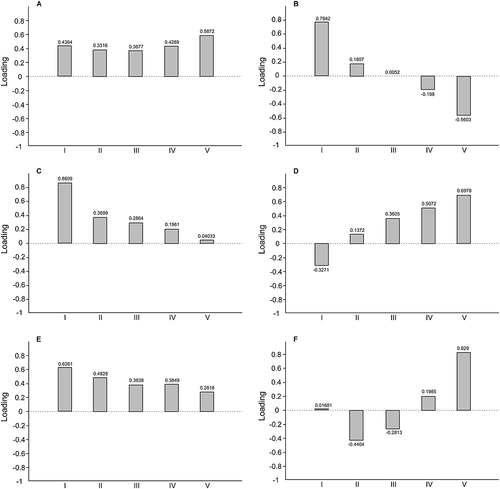
Appendix 3
| Specimen | I | II | III | IV | V |
|---|---|---|---|---|---|
| MNG 10072 | 2.71 | 2.16 | 4 | 3.43 | 3.63 |
| MNG 1351 | 3.6 | 2.52 | 3.61 | 2.52 | 3.51 |
| MNG 1515 | 2.07 | 2.53 | 2.04 | 3.97 | 2.45 |
| MNG 1846 | 2.08 | 5.13 | 4.16 | 2.31 | 5.69 |
| MNG 1840 | 2.59 | 3.78 | 5.36 | 5.27 | 4.24 |
| Standard deviation in manus | |||||
| Specimen | I | II | III | IV | V |
| MNG 10072 | 1.15 | 5.03 | 2.52 | 4.58 | 4.58 |
| MNG 1351 | 1.87 | 2.07 | 1.52 | 4.45 | 0.44 |
| MNG 1515 | 6.55 | 6.19 | 6.61 | 6.25 | 7.12 |
| MNG 1846 | 2.75 | 3.37 | 4.9 | 3.46 | 2.99 |
| MNG 1840 | 4.98 | 2.26 | 3.58 | 3.37 | 2.32 |



